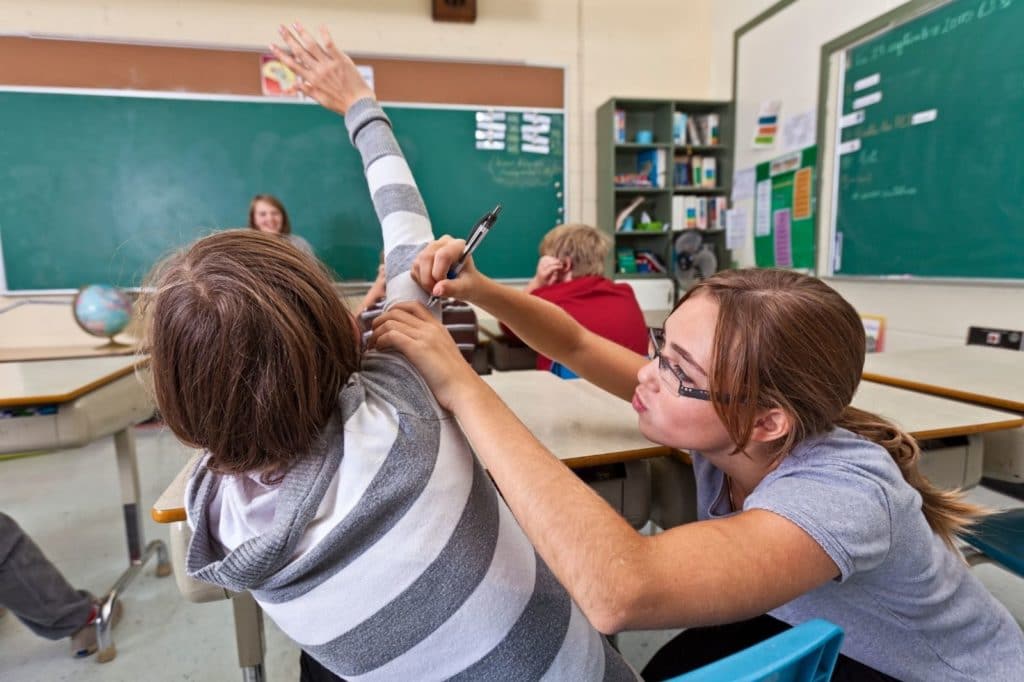When a student is consistently disruptive, they present a disturbance to you and the rest of your class. Disruptive students can interrupt you or their classmates with both verbal and nonverbal disturbances. Verbal disruptions can include talking with others, grandstanding and monopolizing discussions, or distracting you or classmates with excessive or non-lesson-related requests. Nonverbal disruptions can include excessive tardiness, writing or passing notes, using electronics, or silently antagonizing you or their classmates. Whether they’re being verbally or nonverbally disruptive, disruptive students are not interested in participating in the material or activity you want them to pay attention to at the moment.
When a student is consistently disruptive, whether they’re on the quiet or loud end of the behavior spectrum, the bottom line is they’re refusing to engage in an appropriate way. Your next step after identifying this problem behavior is to effectively manage it, and help prevent it from happening.
Make your expectations crystal clear
Students need you to be specific. When you speak in general terms, like saying, “don’t be disruptive,” you’re not being specific enough. Students don’t necessarily have the comprehension skills to understand what you mean by that and how you’re expecting them to adjust their behavior. Furthermore, telling students what not to do isn’t as effective as telling them what to do.
If you’re struggling with a student who is consistently disruptive, try giving them very direct steps like, “I need you to leave your classmate alone. Stop talking to him. Put both feet on the ground and turn to face the front. Keep your eyes on the board, and follow along.”
Pay attention to the timing
When you have a student who’s consistently disruptive, you need to determine what’s triggering that behavior. Do you notice the student starts being disruptive when you transition from one activity to another? Maybe when you move from math to reading, your student gets unplugged somehow. They get loud, they distract others, and they create some kind of disturbance you need to manage instead of getting to the subject matter.
Consider: What is it about this time or activity that creates a problem situation or leads to problem behaviors? Look at the conditions that are bringing about this behavior. Maybe this student really doesn’t like reading and needs some extra help. Maybe they’re uncomfortable with the material, and that’s why they want to create a disruption.
Try to isolate the conditions that bring on the problem behavior. That way, you’ll have a better understanding of when it’s most likely to happen, and identify the root cause. Then, you can make more targeted adjustments from there that speak to what is causing the student to be disruptive.
Consider function over form: attention or escape
You might have three different students who engage in disruptive behavior, and the reasons why they’re doing it could also be completely different. Pay attention to what that student is getting out of this problem behavior. When you consider the function of the problem behavior, you’re considering: What’s the payoff for them? Try not to be as concerned with the details of what they’re doing, so much as why they’re doing it. You need to figure out the root cause behind the behavior first before you can best determine where to go next.
For example, a simple assumption is that a student may be consistently disruptive because they’re trying to get attention. Do you find that you’re giving them undivided attention more often when they’re being disruptive? You’ve got to get them to stop the disruptive behavior so the rest of the class can continue, right? They might consider that attention a payoff for this problem behavior. If you focus on them every time they’re disruptive, even if that attention is negative and includes adverse consequences, you may be unwittingly reinforcing the problem behavior. The function of being disruptive, in this case, is to get more access to your dedicated attention.
If it looks like the student wants more attention, consider how you can encourage them to use more appropriate behaviors to get it. You might minimize or remove all of your attention from that student until they behave the way you need them to. You might also use differential reinforcement, which is to increase your positive feedback with other students who are appropriately engaging. Your challenging student isn’t receiving attention. When you increase the level or quality attention to other students, you’re sending a message that appropriate behavior is rewarded with the attention that your attention-seeking student is after.
The student might be disruptive because they’re trying to escape. Do you see they have difficulty with the subject matter, or struggle with the material? Maybe they want to avoid the topic or deflect attention away from their other deficiencies by creating new ones to address instead. The function of being disruptive for this student may be to avoid having to struggle with something they’d rather not deal with. Maybe they don’t want to be singled out in front of peers.
If they’re trying to escape, try to get them to communicate about what’s going on. Acknowledge that this seems like a difficult time for them, and start with where they are. Ask, “What about this time or activity is creating this situation where you would prefer to create a disruption instead?” Consider offering them a chance to ask for a break, and let them know when you’ll expect them to come back ready to participate in a more productive way.
You can also empower them with a choice. For example, let them know, “You have these two things that need to get done, and you can decide which one you need to do first.” You might also let them know it’s ok to ask for help, even write you a note, and make yourself available. Again, getting down to the core of why they’re being disruptive will help you develop an appropriate response.
Implement behavioral interventions
These steps can help as you work through how to handle a student who is consistently disruptive:
- Stay calm. Stay neutral. Assess in the moment what seems to be driving this behavior.
- Verify your concern. Try to get your student to communicate about what’s going on. “It looks like you’re having a difficult time. What is it about this time/activity that is causing you to show these behaviors?”
- Ask the student to help you understand what they need. They might not have the language to say it on their own, so be ready to offer some suggestions and teach them how to ask for help.
- Give specific examples of support. Students thrive when they feel empowered and can exercise some choice.
- Provide an alternative for that student and get everybody else set up and go back to the student having the problem.
When to get more help
Your student might be consistently disruptive because they have a developmental or emotional disorder that needs diagnosis and further intervention. You are a teacher, and not a diagnostician. It’s not up to you to singlehandedly diagnose what’s going on with students who don’t respond to your efforts to manage their behavior.
That’s why it’s important to implement behavioral interventions sooner rather than later. Don’t wait longer than a few weeks to address problem behaviors in your classroom. If you’re not seeing progress after a week or two, then it’s time to engage a team for more support. Your school psychologist or counselor, behavioral specialist, principal, along with the student’s parents can all start looking at the problem behavior and consider what variables they can control to create the best environment for that student to succeed. Early intervention is key to a successful outcome, and will help you manage your classroom better in the long run.










